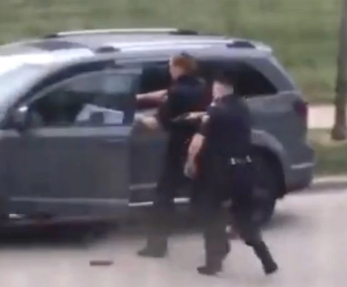
A Shocking Act of Violence Shakes the Healthcare Industry: On a crisp December morning in 2024, the bustling streets of Midtown Manhattan became the stage for a brazen act of violence that would send shockwaves through the healthcare industry and beyond. Brian Thompson, the CEO of UnitedHealth Group, one of the largest health insurance companies in the United States, was gunned down in broad daylight outside a luxury hotel.
The assassination, carried out with chilling precision, left the nation stunned and raised alarming questions about the safety of high-profile executives and the deep-seated frustrations within the American healthcare system. As details of the shooting emerged, a complex web of conspiracy theories began to take shape, fueled by social media speculation and public outrage over the state of healthcare in America.
The Assassination: A Carefully Orchestrated Attack
Eyewitness accounts and surveillance footage painted a picture of a meticulously planned operation. The assailant, described as a man in his late 30s or early 40s, had apparently studied Thompson’s routine and chosen his moment with calculated precision.
In the final moments before the attack, the gunman approached Thompson from behind, brandishing a suppressed handgun – a detail that would later become a focal point of intense speculation. With cold efficiency, he fired multiple shots at close range, ensuring his target had no chance of survival.
What struck investigators and the public alike was the assassin’s apparent professionalism. He cleared a weapon malfunction with ease, suggesting military or law enforcement training. After the shooting, he calmly fled the scene on a bicycle, following what appeared to be a pre-planned escape route.
The Immediate Aftermath: A Manhunt and Public Reaction
As news of the assassination spread, law enforcement launched a massive manhunt. The NYPD, FBI, and other agencies pooled their resources, combing through surveillance footage and interviewing witnesses. The public was captivated by the unfolding drama, with social media platforms buzzing with theories and commentary.
Within days, a breakthrough came. A man matching the shooter’s description was detained in Altoona, Pennsylvania. He was found carrying a fake New Jersey ID and a firearm similar to the one used in the assassination. Additionally, investigators recovered a computer, potentially holding crucial evidence.
The suspect was identified as Luigi Mangione, though details about his background and potential motives remained scarce. This lack of information only served to fuel the growing number of conspiracy theories surrounding the case.
Conspiracy Theories Emerge: From Vigilante Justice to Corporate Intrigue
As the investigation progressed, a myriad of conspiracy theories began to circulate online, each more intriguing than the last. These theories ranged from plausible to outlandish, reflecting the public’s deep-seated mistrust of both the healthcare system and corporate America.
The Vigilante Hero Theory
One of the most popular theories to emerge portrayed the assassin as a vigilante hero, striking a blow against a corrupt healthcare system. Proponents of this theory pointed to a handwritten manifesto allegedly found in the suspect’s possession, which expressed the belief that healthcare insurance companies prioritize profit over patient care.
This narrative resonated strongly with many Americans who had personal grievances against health insurance companies. Social media platforms were flooded with stories of denied claims, exorbitant bills, and lives lost due to inadequate coverage. The assassin, in this light, was seen as a desperate individual pushed to the brink by a broken system.
The Professional Hit Theory
Contrasting with the vigilante narrative, some speculated that the assassination was a professional hit, possibly orchestrated by rival corporations or even foreign entities seeking to destabilize the American healthcare system. The shooter’s apparent skill and the use of a suppressed weapon were cited as evidence of professional training.
Conspiracy theorists pointed out that the attack’s precision and the assassin’s calm demeanor suggested more than just a disgruntled individual. They argued that such a high-profile target would require resources and planning beyond the capabilities of a lone wolf.
The Inside Job Theory
A more sinister theory proposed that the assassination was an inside job, orchestrated by elements within UnitedHealth itself. Proponents of this theory suggested that Thompson may have been about to expose corruption within the company or implement reforms that threatened powerful interests.
While lacking concrete evidence, this theory played into broader narratives about corporate malfeasance and the cutthroat nature of American capitalism. It also tapped into a general distrust of large corporations, particularly in the healthcare sector.
The False Flag Operation Theory
Perhaps the most extreme theory to gain traction was the idea that the assassination was a false flag operation, designed to garner sympathy for healthcare executives and deflect criticism from the industry. According to this theory, the entire event was staged to paint critics of the healthcare system as dangerous extremists.
Proponents of this theory pointed to the immediate media coverage and the swift capture of a suspect as evidence of a pre-planned narrative. They argued that the assassination would be used to justify increased security measures and potentially even legislation to protect healthcare executives, effectively silencing criticism.
The Ripple Effects: Healthcare Industry on Edge
Regardless of the truth behind the theories, the assassination had immediate and far-reaching consequences for the healthcare industry. CEOs of major health insurance companies and hospital networks suddenly found themselves potential targets, leading to a dramatic increase in personal security measures.
The incident also sparked a renewed debate about the state of healthcare in America. Supporters of healthcare reform seized on the assassination as evidence of the deep-seated anger and frustration felt by many Americans towards a system they view as broken and exploitative.
In the days following the shooting, several major health insurance companies announced policy changes, seemingly in response to the public outcry. Aetna, for instance, rolled back a controversial announcement regarding anesthesia coverage, a move widely interpreted as an attempt to appease public sentiment.
The Weapon: A Clue or a Red Herring?
One of the most intriguing aspects of the case was the weapon used in the assassination. Described as a suppressed handgun, it quickly became a subject of intense speculation. Some experts suggested it might have been a Welrod, a specialized assassination weapon developed during World War II.
The choice of such an unusual and specific weapon added fuel to theories about the assassin’s professional background. Gun enthusiasts and conspiracy theorists alike pored over the limited available information, debating the significance of this detail.
The use of a suppressor, which is heavily regulated under the National Firearms Act, also raised questions about how the assassin obtained the weapon. This led to discussions about the effectiveness of gun control laws and the black market for firearms.
Social Media: The Court of Public Opinion
As the investigation unfolded, social media platforms became a battleground of ideas and theories. Reddit, in particular, saw intense discussions across various subreddits, from r/news to r/conspiracy. Users debated the morality of the act, the state of healthcare in America, and the potential consequences of the assassination.
One Reddit user’s comment encapsulated the conflicted feelings many expressed: “Obviously, murder is wrong, but this feels like a wake-up call for an industry that’s been exploiting people for too long. It’s tragic, but maybe now they’ll actually listen.”
Others warned of the dangers of vigilantism and the potential for copycat attacks. “This sets a dangerous precedent,” another user wrote. “Today it’s a healthcare CEO, but where does it end? We can’t condone violence, no matter how justified it might feel.”
The Broader Context: A Symptom of a Larger Problem?
As the dust settled and the initial shock wore off, many began to view the assassination not as an isolated incident, but as a symptom of deeper issues within American society. The healthcare system, long a source of frustration for many Americans, was suddenly under intense scrutiny.
Critics pointed to the vast disparities in healthcare access and quality, the high costs of medical treatment and insurance, and the profit-driven nature of the healthcare industry as factors contributing to a climate of anger and desperation. They argued that while the assassination was unjustifiable, it was also a predictable outcome of a system that prioritizes profits over people’s lives.
Supporters of the current healthcare system, on the other hand, condemned the act as terrorism, warning that it could lead to a breakdown of civil society if left unchecked. They argued for increased protection for healthcare executives and stricter penalties for those who threaten them.
The Investigation Continues: More Questions Than Answers
As the investigation into the assassination of Brian Thompson continues, more questions than answers remain. The true identity and motivations of the assassin, the extent of any potential conspiracy, and the long-term implications for the healthcare industry and American society at large are still unclear.
What is certain, however, is that the events of that December morning in 2024 have forever changed the landscape of American healthcare. Whether this change will ultimately lead to positive reforms or further entrenchment of the status quo remains to be seen.
As the nation grapples with the aftermath of this shocking act of violence, one thing is clear: the conversation about healthcare in America has been irrevocably altered. The assassination of Brian Thompson may well be remembered as a turning point in the ongoing debate about the future of healthcare in the United States.







